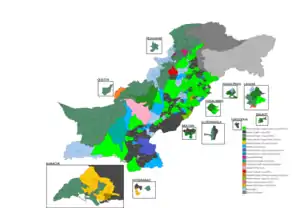2002 Pakistani general election
General elections were held in Pakistan on 10 October 2002 to elect the National Assembly and four provincial assemblies.
| |||||||||||||||||||||||||||||||||||||||||||||||||||||||||||||||||||||||
All 342 seats of the National Assembly 172 seats needed for a majority | |||||||||||||||||||||||||||||||||||||||||||||||||||||||||||||||||||||||
|---|---|---|---|---|---|---|---|---|---|---|---|---|---|---|---|---|---|---|---|---|---|---|---|---|---|---|---|---|---|---|---|---|---|---|---|---|---|---|---|---|---|---|---|---|---|---|---|---|---|---|---|---|---|---|---|---|---|---|---|---|---|---|---|---|---|---|---|---|---|---|---|
| Turnout | 41.8% ( | ||||||||||||||||||||||||||||||||||||||||||||||||||||||||||||||||||||||
| |||||||||||||||||||||||||||||||||||||||||||||||||||||||||||||||||||||||
 Results of elections showing political parties.
 Parliament House Islamabad | |||||||||||||||||||||||||||||||||||||||||||||||||||||||||||||||||||||||
| |||||||||||||||||||||||||||||||||||||||||||||||||||||||||||||||||||||||
 |
|---|
| This article is part of a series on the politics and government of Pakistan |
|
|
The elections were held under the military government of Pervez Musharraf.[1] The two mainstream parties, the Pakistan Peoples Party (PPP) and Pakistan Muslim League (N) (PML-N), had several restrictions imposed on them and their leaders Benazir Bhutto and Nawaz Sharif were in exile. In order to address the restrictions, the PPP created the Pakistan Peoples Party Parliamentarians (PPPP) under the leadership of Ameen Faheem, to contest the elections on its behalf. The PML-N was also suffering from the party's division into two factions: one that remained loyal to Sharif and were contesting the elections under the leadership of Javed Hashmi, and the other which had broken away to form the pro-Musharraf Pakistan Muslim League (Q) (PML-Q).
The emergence of the PML-Q marked the beginning of a multi-party system in the country, bringing an end to the decade-long two-party system between the PPP and PML-N. Although its senior leadership was conservative, the PML-Q ideologically aligned themselves with Musharraf's liberal views. In opposition to the liberal regime of Musharraf, Islamist parties organised themselves into the Muttahida Majlis-e-Amal (MMA) alliance, bringing another key player into the political arena.
In the National Assembly elections, the PPPP received the most votes but the PML-Q won the most seats, winning 126 to the PPPP's 81. At the provincial level, the MMA emerged as the largest party in Balochistan and North-West Frontier Province. The PML-N lost its stronghold of Punjab to the PML-Q, while in Sindh there was a hung parliament, with the PPP winning more seats than the National Alliance. Voter turnout was 41.8%.
Although the founder of the PML-Q Mian Muhammad Azhar was considered the most likely candidate to become Prime Minister, he failed to win a seat in the National Assembly. Instead a senior party leader Zafarullah Khan Jamali was tasked with leading the new government. Meanwhile, the MMA leader Fazal-ur-Rehman became the Leader of the Opposition.
Parties and candidates
More than 70 parties, contested the election, the main parties were the Peoples Party Parliamentarians, Pakistan Muslim League-Nawaz Group, Muttahida Quami Movement (MQM), Pakistan Muslim League-Quaid-i-Azam also called the "King's Party" for its unconditional support to the government, and the Muttahida Majlis-i-Amal (MMA), alliance of six religious political parties. Other known parties contesting at the national level included the six-party National Alliance led by former President Farooq Ahmad Lagari, Imran Khan's Pakistan Tehrik-i-Insaaf and Tahir-ul-Qadri's Pakistan Awami Tehrik.[1]
Results
Summary of the October 2002 National Assembly elections[2]
| Votes | % | Seats | |
|---|---|---|---|
| Pakistan Muslim League (Quaid-e-Azam) | 7,500,797 | 25.66 | 126 |
| Pakistan Peoples Party Parliamentarians | 7,616,033 | 26.05 | 81 |
Muttahida Majlis-e-Amal Pakistan
|
3,335,643 | 11.41 | 63 |
| Pakistan Muslim League (Nawaz) | 3,409,805 | 11.66 | 19 |
| Muttahida Qaumi Movement | 932,166 | 3.19 | 17 |
| National Alliance | 1,395,398 | 4.77 | 16 |
| Pakistan Muslim League (Functional) | 328,923 | 1.13 | 5 |
| Pakistan Muslim League (Junejo) | 283,755 | 0.97 | 3 |
| Pakistan Peoples Party (Sherpao) | 98,476 | 0.34 | 2 |
| Pakistan Tehreek-e-Insaf (Pakistan Movement for Justice) | 242,472 | 0.83 | 1 |
| Pakistan Awami Tehreek (Pakistan People's Movement) | 202,845 | 0.69 | 1 |
| Jamhoori Wattan Party (Republican National Party) | 96,240 | 0.33 | 1 |
| Pakistan Muslim League (Zia-ul-Haq Shaheed) | 78,798 | 0.27 | 1 |
| Balochistan National Party | 57,865 | 0.20 | 1 |
| Pakhtun-khwa Milli Awami Party | 96,252 | 0.33 | 1 |
| Independents | 2,722,669 | 9.31 | 3 |
| Non-partisans (most joined one of the above parties) | - | 14.1 | 21* |
| Female elected members (included in party seats above) | . | . | 60* |
| Minorities (included in party seats above) | . | . | 10* |
| Total (turnout 41.8%) | 29,236,687 | 100 | 342 |
| Source: Pakistan Electoral Commission, Free and Fair Election Network and CIA Factbook
Not included in total. Except for three independents, most of these are included in the party-seat numbers | |||


.png.webp)
.jpg.webp)